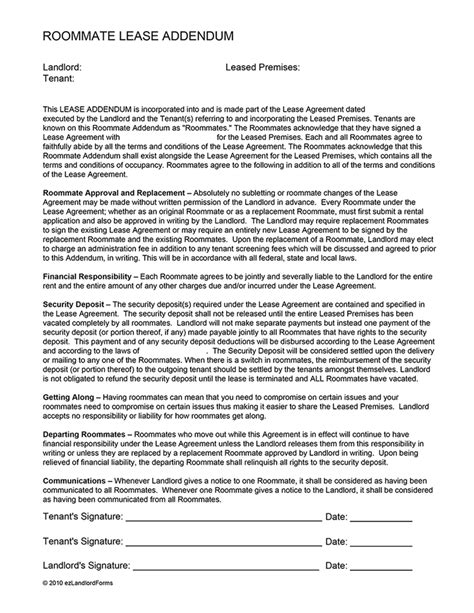Adding a Roommate? Lease Amendment 101: A Comprehensive Guide
Adding a roommate can be a great way to reduce housing costs and enjoy shared living. However, it's crucial to understand the legal implications and how to navigate the process correctly, especially regarding your existing lease agreement. This guide will walk you through the essential steps and considerations when adding a roommate, focusing on lease amendments.
What is a Lease Amendment?
A lease amendment is a legally binding document that modifies the original terms of your lease agreement. It's not a simple addendum; it requires the signature of all parties involved – you, your current landlord, and your prospective roommate. This ensures everyone is aware of and agrees to the changes. Attempting to add a roommate without a formal amendment could lead to legal complications and potential lease violations.
Why is a Lease Amendment Necessary When Adding a Roommate?
Your original lease likely specifies the number of occupants allowed. Adding a roommate without landlord consent violates this clause and could result in penalties, eviction notices, or even lease termination. A lease amendment formally updates the lease to reflect the addition of the new occupant, protecting both you and your landlord.
What Information Should Be Included in a Lease Amendment?
A well-written lease amendment should include the following crucial information:
- Roommate's Full Legal Name: Accuracy is essential here to avoid future confusion.
- Roommate's Contact Information: Include their phone number, email address, and current address.
- Effective Date of the Amendment: Clearly state when the changes to the lease take effect.
- Occupancy Clause Update: Specifically mention that the number of occupants has increased, indicating the new total number of residents.
- Responsibility for Rent and Utilities: Clearly define how rent and utility costs will be split between you and your roommate. Will it be a 50/50 split, or a different arrangement based on room size or shared amenities? Be explicit to avoid misunderstandings.
- Signatures of All Parties: All parties to the lease amendment – you, your roommate, and your landlord – must sign and date the document. This legally binds everyone to the updated agreement.
How Do I Get My Landlord's Consent?
Before initiating the amendment process, it’s essential to contact your landlord to seek permission. Some landlords may have specific requirements or forms they prefer you use. Be prepared to provide your roommate's information and answer any questions they might have. If your landlord refuses, you'll need to explore alternative solutions or consider finding a new place to live.
What Happens if My Landlord Refuses to Sign the Amendment?
If your landlord refuses to sign a lease amendment allowing a roommate, you have limited options. You may need to negotiate with them, offering compromises or addressing their concerns. Alternatively, you may need to consider breaking your lease (which usually involves penalties) or finding a new place that allows roommates. Understanding your lease terms is crucial in this scenario.
Can My Landlord Reject a Prospective Roommate?
In most jurisdictions, landlords have the right to refuse a prospective roommate, though they generally cannot do so based on discriminatory reasons (race, religion, national origin, etc.). They may have concerns about the roommate's credit history, rental history, or other factors that could impact the property.
What if My Roommate Moves Out Before the Lease Ends?
This situation requires revisiting the lease agreement. You need to notify your landlord of your roommate's departure and discuss how this impacts the remaining lease terms. Generally, you remain responsible for the full rent unless the lease explicitly allows for substitution of tenants.
Conclusion: Protect Yourself with a Formal Lease Amendment
Adding a roommate can be advantageous, but it's crucial to handle the process correctly. A formal lease amendment protects both you and your landlord, minimizing the risk of legal disputes and ensuring a smooth living arrangement. Always communicate clearly with your landlord and your roommate, ensuring that all parties are in agreement with the terms of the revised lease. By following these guidelines, you can navigate the process successfully and enjoy the benefits of shared housing without the headaches of legal complications.

